
As coronavirus outbreaks are slowly brought to heel in many places around the world, the US is among a handful of countries facing a surge of new infections.
More than two dozen states are now seeing increases in new cases over the last 14 days.
Of these, Texas, Florida, Arizona and California have emerged as the country’s latest virus epicentres.
But while cases are clearly rising, state leaders and health experts are divided on the cause.
Here’s a look at these four US hotspots, the facts and figures raising alarm, and the theories that may help explain each surge.
What about testing?
First, it’s important to note that across the US, more efficient testing has played some role in the climbing case count. The number of Covid-19 tests being administered now is nearly double what it was in April and May.
But the positive test rate tells us that testing can’t explain away the rise.
If lots of tests are being conducted and the spread of the coronavirus has been reduced, then the positive case rate would fall in tandem. The World Health Organization says that states should have a positive case rate at or below 5% for two weeks before they loosen restrictions on movement.
Even with testing success stories, it’s clear that the southern and western US are seeing a particularly sharp spike in infections and their rate.

As of 30 June, Texas, Florida, Arizona or California all fall under that category – and all fail to meet the bar.
Texas
After nearly three months of new cases hovering between 1,000 and 2,000 each day – Texas’ infection count has spiked in the last two weeks, with up to 6,000 new illnesses reported in a single day.
The sharp rise in cases has been mirrored by record highs in hospital admissions – reaching at 5,913 on Monday – and stoking fears that the state’s hospitals will soon be overwhelmed.
If this trajectory persists, Houston, the state’s most populous city, “would become the worst affected city in the US”, possibly rivalling what’s happening now in Brazil, wrote Peter Hotez, director of the Center for Vaccine Development at Texas Children’s Hospital, on Twitter. “I cannot really see how things get better on their own.”
Why the rise? Many point to the south-western state’s leading role peeling back lockdown measures.
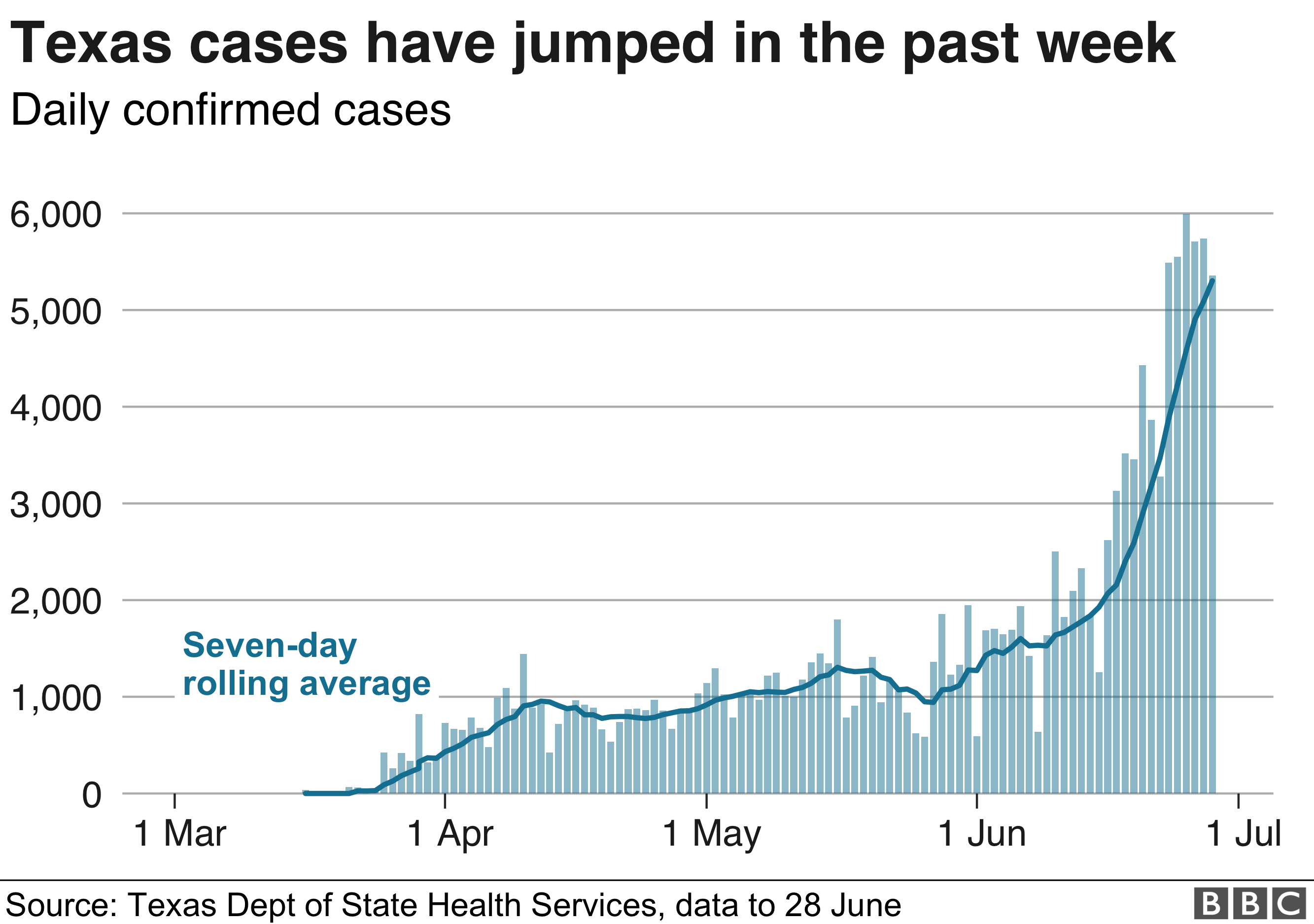

Texas Governor Greg Abbott allowed his stay home order to expire on 30 April, with almost all businesses – including bars and restaurants – operating to at least 50% capacity by early June. Last week, amid the surge, the governor shut down all bars and ordered restaurants to cut down capacity from 75 to 50%.
“If I could go back and redo anything, it probably would have been to slow down the opening of bars,” Mr Abbott said to El Paso station KVIA-TV. A “bar setting, in reality, just doesn’t work with a pandemic”.
Packed restaurants and bars may also fit with another national trend: the average age of people diagnosed with Covid-19 has decreased gradually throughout the pandemic.
In certain counties, people under the age 30 make up the majority of Covid patients, Mr Abbott said at a press conference earlier this month, which “typically results from people going to the bar-type settings”.
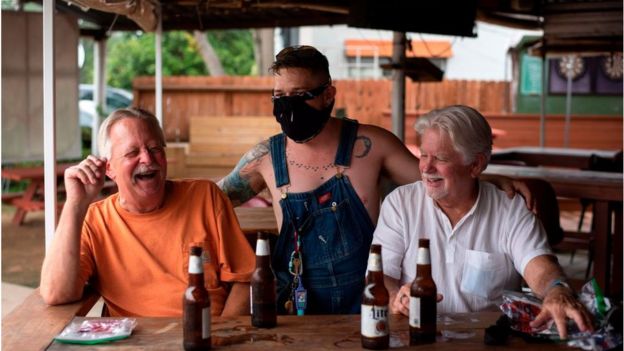
Parts of the state are now also enacting rules on face coverings.
Policies on masks are one of the factors differentiating states like Texas from those seeing lower transmission rates.
In 11 states with mask rules in place – including New York and Illinois – the number of new cases has declined 25% in the last two weeks, according to an analysis by the Philadelphia Inquirer. On the other hand, in states where only some employees have to wear masks, new cases have risen by an average of 70%.
Florida
Florida’s stay home order expired shortly after Texas’, on 4 May.
While the state’s most populous counties, Miami-Dade and Broward, held off until 18 May, Florida still had one of the more aggressive reopening strategies in the US.
Disney properties and beaches began reopening by the end of last month, just as Americans across the country celebrated the Memorial Day holiday. Days into June, bars, restaurants, gyms, and shops were also resuming business.
Now, the Sunshine State is seeing a surge in Covid-19 – this past weekend saw over 8,500 new cases per day. In the last two weeks, cases have increased fivefold, according to the New York Times.
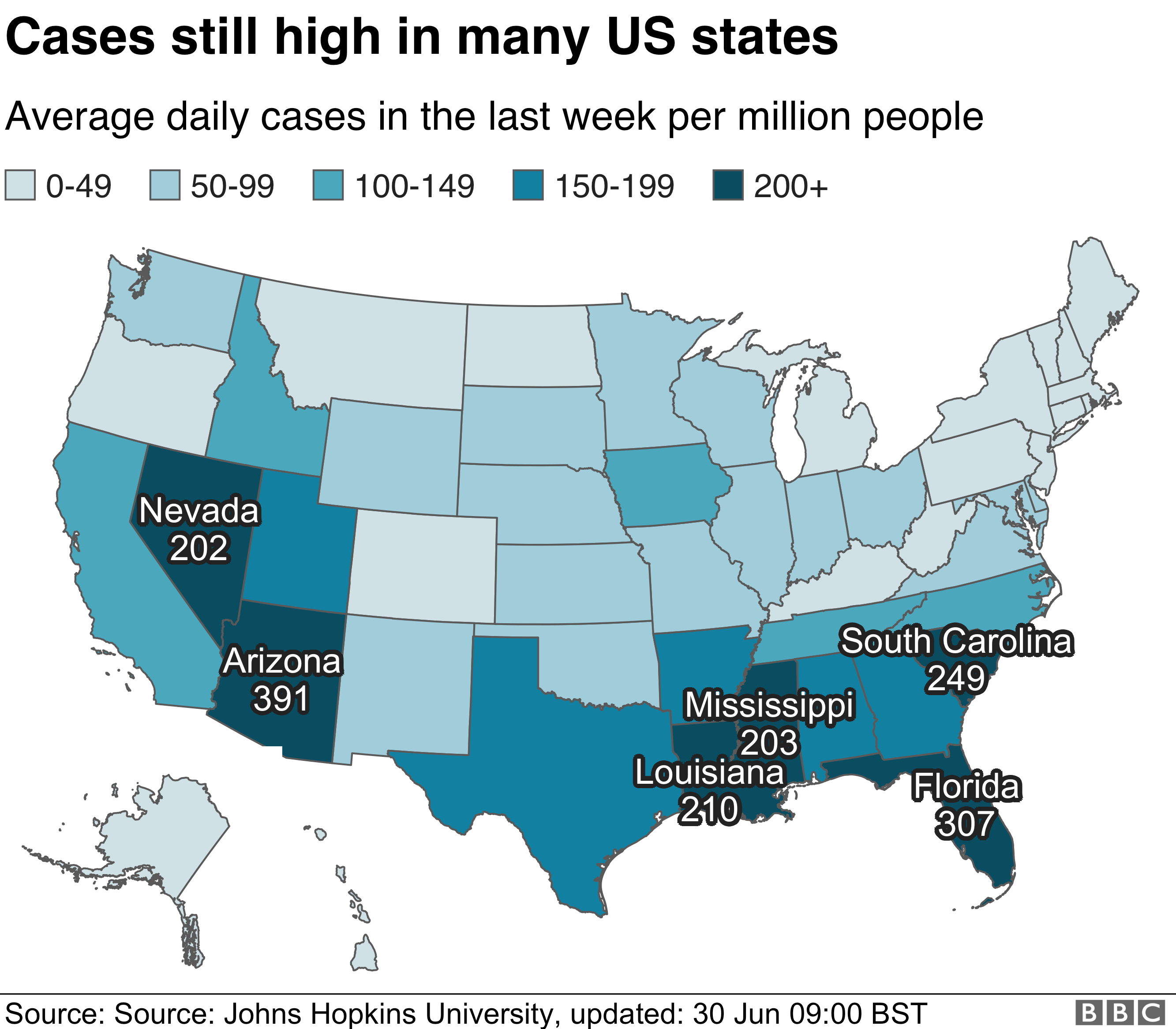

Hospitalisations are up as well, but Florida’s death toll has not seen so sharp a rise thus far.
The governor’s answer for why that may be lines up with what the White House has said: more testing and more young people with infections.
Republican Governor Ron DeSantis said a backlog “test dump” coupled with transmission in the 18 to 35 age range is behind the concerning counts. He said that 20% of Floridians aged 25 to 34 are testing positive, and called on younger residents to be more careful, citing graduation parties that ignored social distancing rules.
“We’ve been stressing avoiding the three Cs, which are: closed spaces with poor ventilation, crowded places with many people nearby and close-contact settings, such as close-range conversations,” Mr DeSantis said.
But some experts say even with testing, the numbers still point to community spread linked to more social contact.
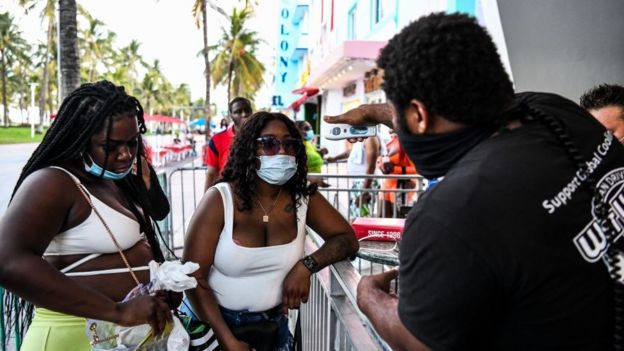
Former CDC Director Tom Frieden told Fox News on Sunday: “As a doctor, a scientist, an epidemiologist, I can tell you with 100% certainty that in most states where you’re seeing an increase, it is a real increase. It is not more tests; it is more spread of the virus.”
Mr DeSantis has stopped short of enacting any mandatory measures to curb Covid-19 transmission – however, mayors in South Florida, the hardest-hit region of the state, have been discussing next steps.
In Miami, Fort Lauderdale and Palm Beach, beaches will be closed for the Fourth of July Independence Day weekend. Miami-Dade County Mayor Carlos Gimenez will also be limiting gatherings to no more than 50 people, with masks required.
Arizona
Arizona may be the region with the most concerning surge in America. In mid-June, a Harvard epidemiologist noted the state had a higher case count and percent positivity rate than Brazil and Peru at the time.
It’s a familiar story here too: the south-western state’s spike follows its reopening timeline.
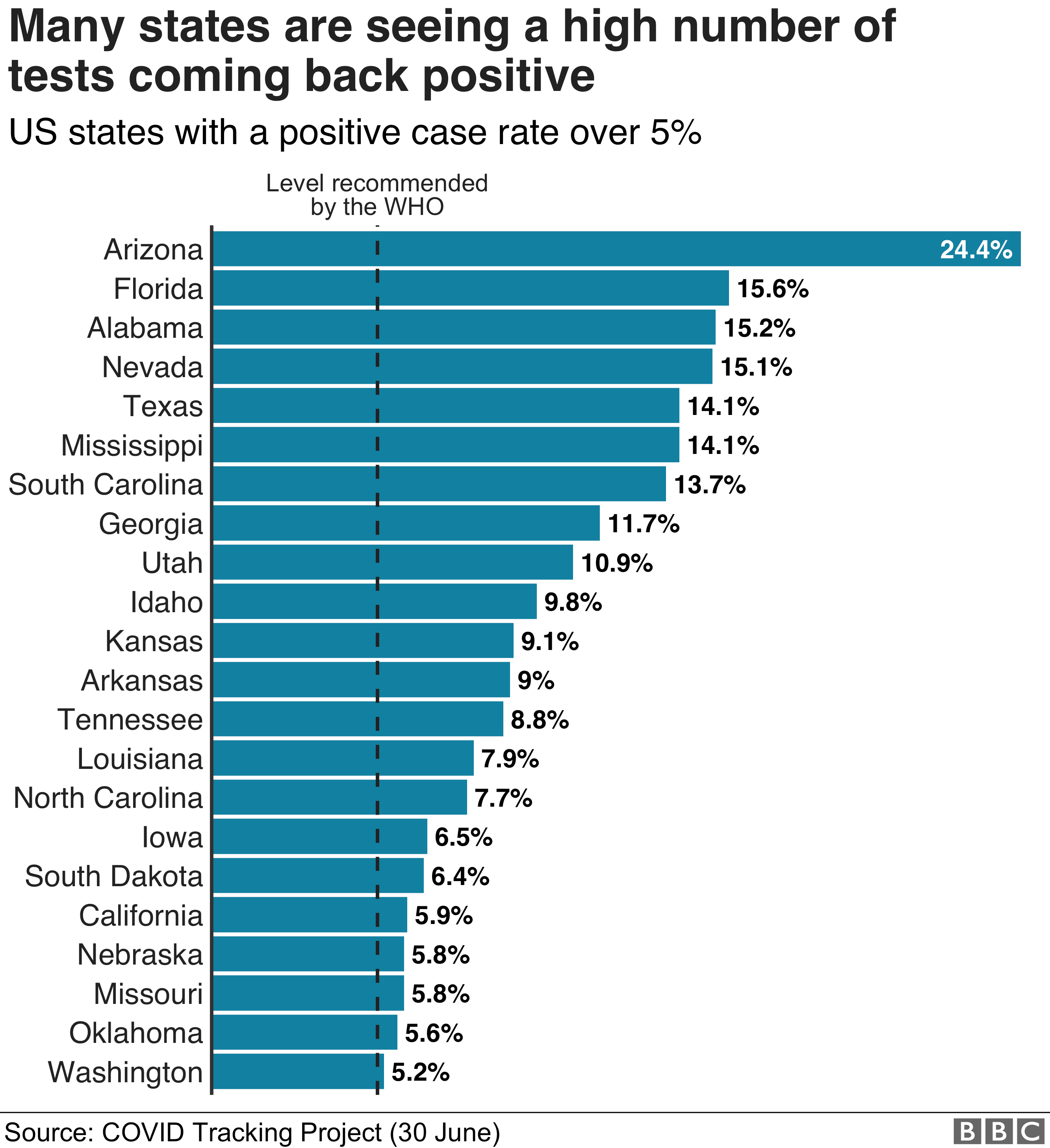

Republican Governor Doug Ducey lifted Arizona’s stay-at-home order on 15 May. In the time since, dine-in restaurants, bars, casinos, gyms, golf clubs and swimming pools reopened. There were health recommendations but no mandate on face coverings or enforcement of social distancing.
As of 30 June, cases have been increasing by 85% in a 14-day period, according to the Covid Exit Strategy tracker. Saturday alone saw a new record of over 3,500 new infections reported.
Arizonians between 20- and 44-years-old make up the bulk of the nearly 80,000 confirmed cases, but 1,200 of its 1,600 deaths are from those aged 65 and up, according to state data. Native Americans make up 18% of the state’s deaths, but just over 5% of the state’s population.
In addition to the case counts, it’s the speed at which they’re increasing that concerns health experts.
Arizona’s summertime climate could be adding to the problem, as many opt for indoor activities thanks to the triple-digit temperatures. Among indigenous groups, some households are without running water, making frequent hand-washing difficult, and live in areas with limited access to healthcare facilities.
There has also been local pushback to following health guidance, with anti-lockdown and, more recently, anti-mask rallies.
Amid this new outbreak, Arizona’s hospitals – which are in emergency mode – have warned intensive care units (ICU) could soon be overwhelmed. Bed space is already in short supply, with 88% of ICU beds and 84% of hospital inpatient beds occupied, according to AZ Central.
The state’s health director on Monday announced hospitals could activate “crisis care standards” that would allow them to prioritise resources to patients based on factors like likelihood of survival.
Following criticism from public health officials and Democrats over his inaction, Mr Ducey ordered bars, nightclubs, gyms, movie theatres and water parks to shut for at least 30 days to “relieve stress” on the healthcare system on 29 June.
California
Of the four states hit hardest by the resurgence, California is in many ways an outlier.
Its 19 March stay home order – the first in the nation – is widely credited with helping guard against the death tolls seen in other large states like New York and New Jersey.
But two months after Governor Gavin Newsom said the Covid curve had “arguably flattened”, cases are now sharply on the rise, hitting an all-time single day high of new cases on 30 June, with 8,086 confirmed new cases. Hospital admissions jumped 43% in the last two weeks.
Los Angeles County has the most Covid-19 cases confirmed in the nation, at over 100,000 as of 30 June, according to a Johns Hopkins University count. Local health officials have warned that one in 140 residents may unknowingly have the virus – last week, that estimate was one in 400.
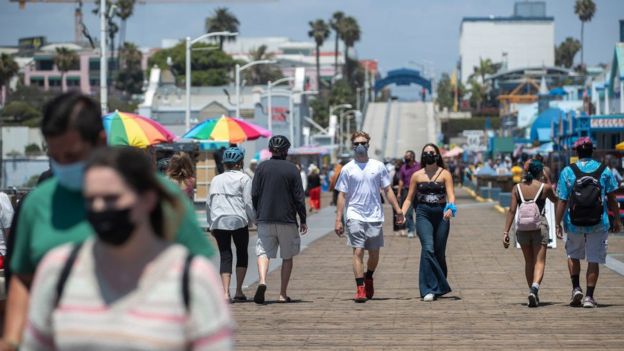
California officials pin the surge in part to a rise in social and family gatherings, particularly among residents in the 18-49 age group, who make up the majority of California’s positive cases.
Easing restrictions on indoor businesses, like gyms and restaurants, likely also played a role. State leaders have also noted that many bars and restaurants were not following social distancing protocols or requiring face coverings.
Seven counties on Sunday, including Los Angeles, were ordered to shut their bars. Counties and cities, like San Francisco, have reversed reopening plans. Disney also delayed plans to reopen, citing a lack of guidance from the state.
Clusters of the virus have emerged in prisons, nursing homes, as well as rural and urban areas.
The San Francisco Bay Area’s San Quentin Prison reported more than 1,000 Covid-19 cases among its 3,500 inmates this week, following a transfer earlier this month from a prison experiencing an outbreak.
State data also shows a significantly higher number of Latino residents have been infected: Latinos account for around 39% of the state’s population, but 56% of the total positive cases as of 30 June.
California’s big cities, like thousands across the nation, also saw massive protests in the wake of George Floyd’s death – though we still don’t have data on how those gatherings may affect the virus’ spread.